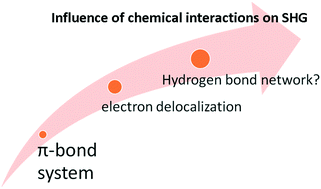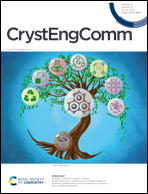Structural diversity of hydrogen-bonded complexes comprising phenol-based and pyridine-based components: NLO properties and crystallographic and spectroscopic studies†
Abstract
Synthesis of compounds with improved physicochemical properties, including nonlinear optical phenomena such as second harmonic generation, might be considered as one of the most challenging aspects of crystal engineering. In this work, we examine the diversity of hydrogen bond networks and relative efficiencies of second harmonic generation in new noncentrosymmetric complexes comprising phenol-based hydrogen bond donors (2,5-dinitrophenol, 4-nitrophenol, 2,3,5,6-tetrachlorophenol) and pyridinium-based hydrogen bond acceptors (2-aminopyridine, 3,5-dimethylpyridine, 2,3,6-trimethylpyridine): 2-aminopyridinium 2,5-dinitrophenolate [(2APy)+·(2,5-DNP)−] (1), 2-aminopyridinium 4-nitrophenolate 4-nitrophenol [(2APy)+·(4-NP)−·(4-NP)] (2), 2,3,6-trimethylpyridinium 2,3,5,6-tetrachlorophenolate [(2,3,6C)+·(TCP)−] (3), and 3,5-dimethylpyridine 2,3,5,6-tetrachlorophenol [(3,5L)·(TCP)] (4). In compounds (1)–(3), proton transfer occurs; specifically, compounds (1) and (3) are classified as salts while compound (2) belongs to the ionic co-crystal class. Only in the case of compound (4), no evidence of proton transfer is found, attesting to its co-crystal nature. The 2,5-DNP molecule was found to possess a short intramolecular O–H⋯O hydrogen bond and crystallize in the monoclinic crystal system with space group P21. Crystal structure analysis reveals that the substituted phenol–pyridine complexes crystallize as salts linked by N–H⋯O hydrogen bonds in the orthorhombic crystal system with space group Pna21, (1) and (2), or P212121 (3), whereas (4) crystallizes in the monoclinic Cc space group as a formally molecular complex (1 : 1) linked by O–H⋯N hydrogen bonds. Additionally, the vibrational study results are also presented. These results have been discussed in the context of the hydrogen bond network present in the investigated crystals. The relative efficiencies of the second harmonic generation (SHG) process for compounds (1)–(4) were examined under 800 nm irradiation using the Kurtz–Perry powder technique. Low SHG efficiency on the order of 10−4vs. that of KDP was observed for compounds (1) and (4), which is ascribed to the self-filtering effect. For these compounds, the two-photon excited fluorescence was additionally registered.



 Please wait while we load your content...
Please wait while we load your content...